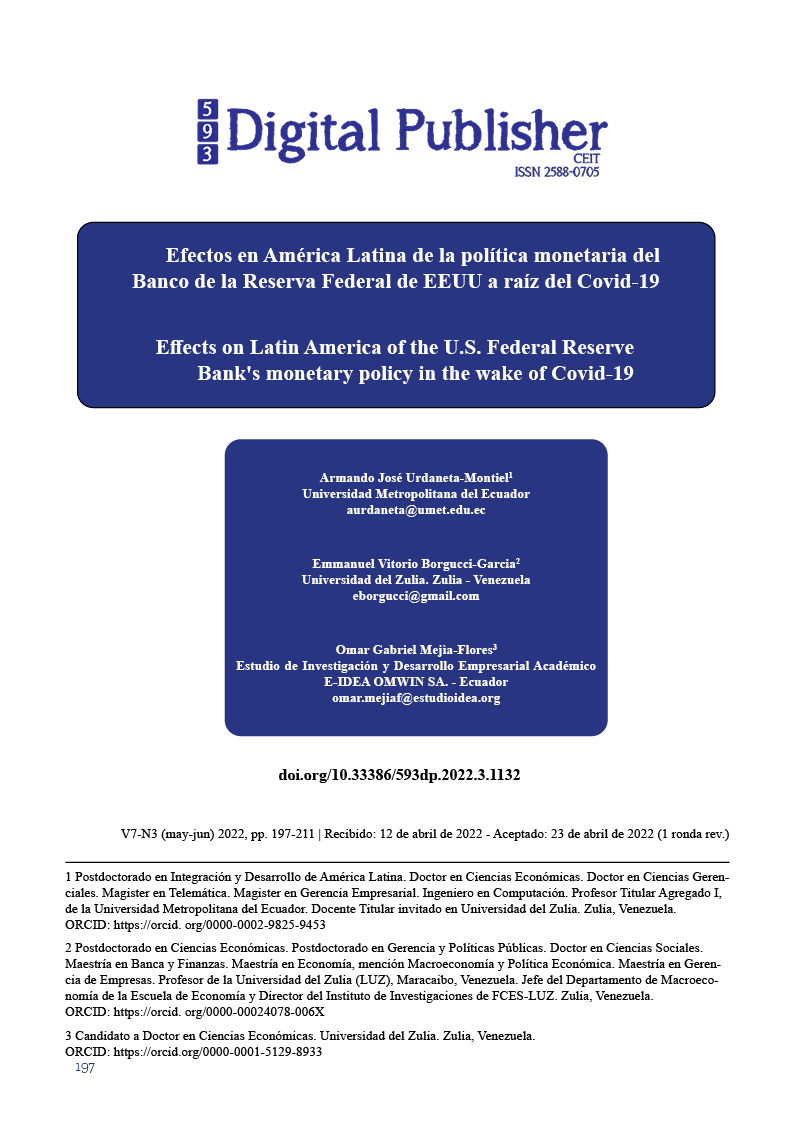Effects on Latin America of the U.S. Federal Reserve Bank's monetary policy in the wake of Covid-19
Main Article Content
Abstract
The objective of this research is to explain the possible effects in Latin America of the Federal Reserve's (Fed) monetary policy due to Covid-19, through the argumentative use of the Austrian and Mundell-Fleming analytical frameworks, taking as theoretical references (Levy, 2017), (McGuinness, Hogan, & Powell, 2018) and (Lee & Bowdler, 2020) among others; The study is explanatory in nature because it goes beyond the mere description of the facts, it establishes relationships between concepts or natural or social phenomena (Hernández, Fernández, & Baptista, 2014). Among the main findings of the study are that: Latin America is the region with the highest inflation rates, with GDP per capita growth lower than other regions of the world, permanent trade balance deficit; the cyclical behaviour that has debt service (% of GDP) which is counter-cyclical with respect to the GDP growth rate and pro-cyclical with respect to foreign direct investment. It is concluded that the monetary policy measures taken, especially by the FED, generate capital outflows and capital flight, as a result of the increase in the cost of capital and devaluations that will erode per capita economic growth in Latin America, when capital migrates from emerging economies to developed economies with the world's main financial centres, as a result of the change in the FED's monetary policy, which goes from expansive to restrictive in order to preserve the dollar's function as a global reserve currency.
Downloads
Article Details

This work is licensed under a Creative Commons Attribution-NonCommercial-ShareAlike 4.0 International License.
1. Derechos de autor
Las obras que se publican en 593 Digital Publisher CEIT están sujetas a los siguientes términos:
1.1. 593 Digital Publisher CEIT, conserva los derechos patrimoniales (copyright) de las obras publicadas, favorece y permite la reutilización de las mismas bajo la licencia Licencia Creative Commons 4.0 de Reconocimiento-NoComercial-CompartirIgual 4.0, por lo cual se pueden copiar, usar, difundir, transmitir y exponer públicamente, siempre que:
1.1.a. Se cite la autoría y fuente original de su publicación (revista, editorial, URL).
1.1.b. No se usen para fines comerciales u onerosos.
1.1.c. Se mencione la existencia y especificaciones de esta licencia de uso.
References
Banco Mundial. (29 de 11 de 2021). Obtenido de Banco Mundial: https://datos.bancomundial.org/indicator
Bishop, T. (13 de Julio de 2021). Institute Mises. Obtenido de “As Inflation Rises, the Fed Is Losing the Narrative”: https://mises.org/power-market/inflation-rises-fed-losing-narrative
Calvo, G., & Reinhart, C. (2002). Fear of Floating. The Quarterly Journal of Economics, 117(2), 379.408.
Cetorelli, N., & Goldberg, L. (2012). Banking Globalization and Monetary Transmission. The Journal of Finance, 67(5), 1811-1843.
De Gregorio, J. (2012). Macroeconomía Teorías y Políticas. Santiago, Chile: McGraw Hill.
Ferrada, B. J. (2003). La autonomía del Banco Central de Chile: Reflexiones acerca de este modelo institucional de gestión de la política monetaria. Revista Chilena de Derecho, 30(1), 151-166.
Friedman, M. (1963). Inflation: Causes and Consequences. India.: Asia Publishing House for the Council for Economic Education.
Friedman, M. (1969). The Optimum Quantity of Money and Other Essays. Estados Unidos.: (Seven edition). Aldine Publishing Company.
Friedman, M., & Schwartz, A. (1963). A Monetary History of the United States 1867-1970. Estados Unidos: (First edition). Princeton University Press.
Friedman, M., & Schwartz, A. (1982). Monetary Trends in the United States and the United Kingdom: Their Relation to Income, Prices and Interest Rates 1867-1975. Estados Unidos.: (First edition). University of Chicago Press.
Friedman, M., & Schwartz, A. (1986). Has government any role in money. Journal of Monetary Economics, 17(1), 37-62. doi:https://doi.org/10.1016/0304-3932(86)90005-X
Garrison, R. (2015). Tiempo y Dinero la Macroeconomia de la estructura del capital. Madrid: Unión Editorial.
Georgiadis, G., & Feng, Z. (2020). Foreign-currency exposures and the financial channel of exchange rates: Eroding monetary policy autonomy in small open economies? . Journal of International Money and Finance, 1-15.
Gil, L. J. (2015). Relación entre política monetaria y estabilidad financiera:un análisis aplicado para Colombia. Ensayos sobre política económica, 133-148.
Girón, A. (2015). Competencia bancaria y política moentaria en América del Norte. NORTEAMERICA, 39-65.
Gundapaneni, S. (3 de Enero de 2022). Mises Institute. Obtenido de Inflation or Recession? The Fed Faces a Choice.: https://mises.org/wire/inflation-or-recession-fed-faces-choice
Hayek, F. (1978). Denationalisation of Money Then Argument Refined: An Analisys of Theory. Reino Unido: (Third edition) The Institute of Economic Affairs. Reino Unido.
Hernández, R., Fernández, C., & Baptista, P. (2014). Metodología de la Investigación. México D.F.: Mc Graw Hill.
Laureys, L., Meeks, R., & Wanengkirtyoc, B. (2021). European Economic Review, 1-21.
Lee, S., & Bowdler, C. (2020). US monetary policy and global banking flows. Journal of International Money and Finance, 103, 1-9.
Levy, O. N. (2017). Política monetria: qué relación tiene con el creimiento y la estabilidad. Economía Informa(404), 18-24.
Lin, S., & Haichun, Y. (2018). The international credit channel of U.S. monetary policy transmission to developing countries: Evidence from trade data. Journal of Development Economics, 1-31.
Luddy, R. L. (3 de Junio de 2021). Mises Institute. Obtenido de BIDEN AND THE FED ARE CREATING AN INFLATION CRISIS: https://mises.org/power-market/biden-and-fed-are-creating-inflation-crisis?page=2
McGuinness, G., Hogan, T., & Powell, R. (2018). European trade credit use and SME survival. Corp. Financ.(49), 81-103.
Mises, L. (1912). Theorie des Geldes und der Umlaufsmittel. Estados Unidos: (First edition). Ludwig von Mises Institute.
Murray, S. (11 de Septiembre de 2021). Mises Institute. Obtenido de The Federal Reserve’s Assault on Savers Continues: https://mises.org/library/federal-reserves-assault-savers-continues
Shostak, Frank . (15 de 01 de 2022). Instituto Mises . Obtenido de “Stop Pretending Price Inflation Is a Result of “Too Much” Profit: https://mises.org/wire/stop-pretending-price-inflation-result-too-much-profit
VIVEL, B. M. (2012). LA EXPOSICIÓN ECONÓMICA AL RIESGO CAMBIARIO:DELIMITACIÓN CONCEPTUAL Y MODELOS PARA SU ESTIMACIÓN. Revista Galega de Economía, 21(1), 1-8.


